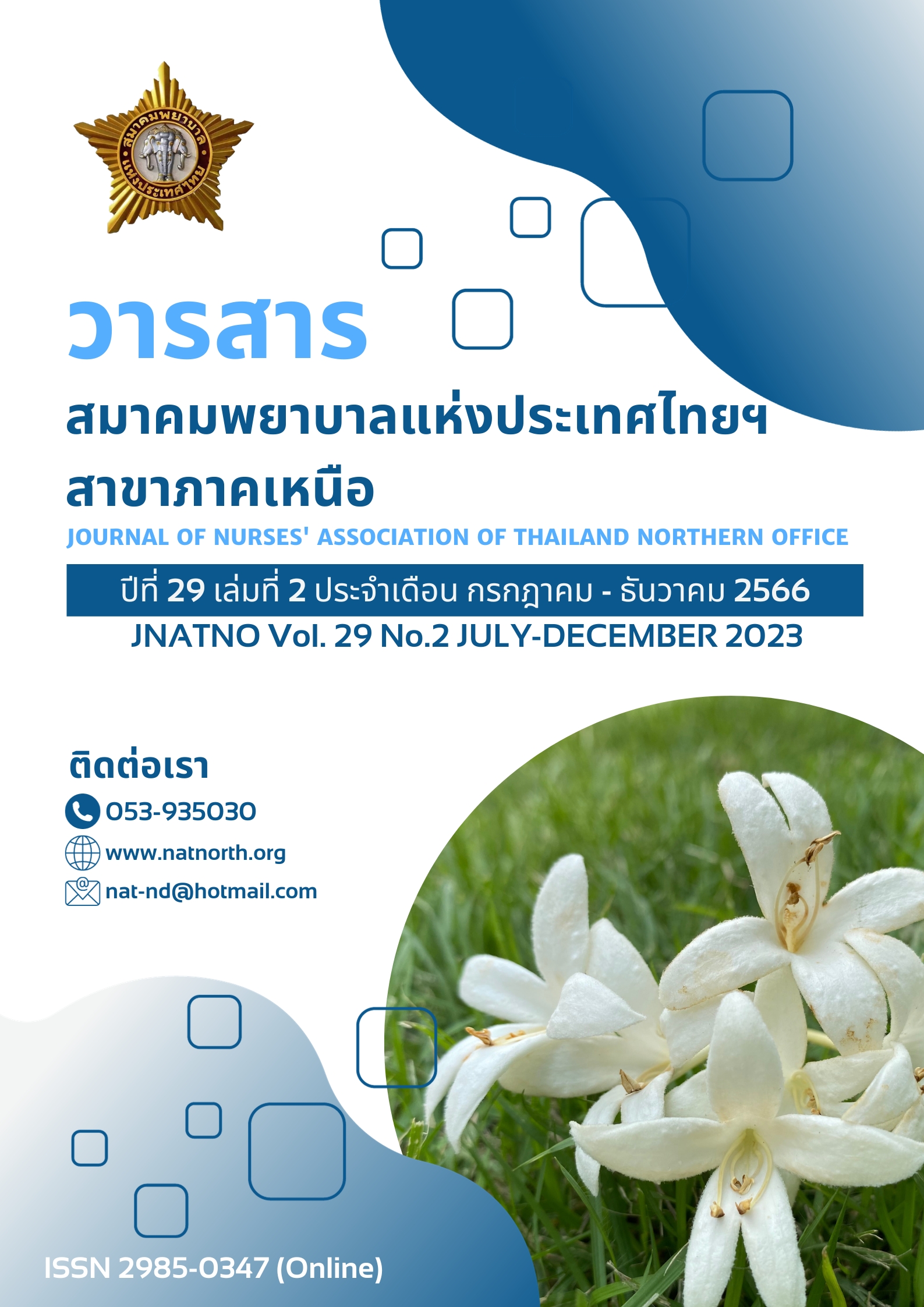The Effects of Implementing FASTHUG and BANDAIDS Concepts on Critical Care Patients in The Intensive Care Unit, Nakornping Hospital
Keywords:
Nursing Practice Guidelines, Critical care nursing, FASTHUG and BANDAIDS conceptsAbstract
This quasi-experimental study aims to investigate the effects of implementing FASTHUG and BANDAIDS concepts on critical care patients in the intensive care unit, Nakornping Hospital. The sample consisted of two groups: 1) intensive care unit nurses (n=40) and 2) two groups of critically ill patients, selected through purposive sampling. The first group was given ordinary nursing care (n=82), and the second group was given care using the nursing practice guidelines based on the principles of FASTHUG and BANDAIDS (n=82). The tools of nursing practice guidelines based on the principles of FASTHUG and BANDAIDS had IOC values at 1.00 and the tools used to collect data include 1) Nurses' practice record of FASTHUG and BANDAIDS concept. 2) Nurses' knowledge assessment of FASTHUG and BANDAIDS concept guidelines. 3) Assessment of nurses' satisfaction with the use of guidelines and 4) Patient clinical outcome record form. IOC values of the tools were assessed at .90, .98, .88, and .88, respectively. Data analysis was performed using descriptive statistics, paired t-test, independent t-test, and chi-square.
The study revealed the following results:
- The nursing outcomes: There was a significantly increase in nurses’ knowledge after using nursing guidelines based on the principles of FASTHUG and BANDAIDS (p< 0.001). After promoting the practice of caring for critical patients based on the principles of FASTHUG and BANDAIDS, the proportion of correct practice by nurses increased significantly (p<0.001). Additionally, the group that utilized the guidelines reported a higher level of satisfaction with their use (Mean=4.47, S.D.=0.68).
- Patient Outcomes: There were significantly decreases in mortality rate, ventilator associated pneumonia rate, weaning failure rate, the unplanned self-extubation, and the length of stay in intensive care unit (p < 0.05).
In summary, after implementing clinical practice guidelines based on FASTHUG and BANDAIDS and effective clinical teaching helps increase quality of care in intensive care unit.
References
กัญจนา ปุกคํา, และ ธารทิพย์ วิเศษธาร. การพัฒนารูปแบบการดูแลผู้ป่วยวิกฤตศัลยกรรมโดยใช้แนวทาง FAST HUG. วารสารวิชาการสาธารณสุข. 2559;25(1):116-27.
โรงพยาบาลนครพิงค์, กลุ่มงานยุทธศาสตร์. รายงานประจำปี 2565 โรงพยาบาลนครพิงค์ จังหวัดเชียงใหม่. เชียงใหม่: โรงพยาบาลนครพิงค์; 2565.
โรงพยาบาลนครพิงค์, ภารกิจด้านการพยาบาล. รายงานประจำปี 2565 โรงพยาบาลนครพิงค์ จังหวัดเชียงใหม่. เชียงใหม่: โรงพยาบาลนครพิงค์; 2565.
วิจิตรา กุสุมภ์ และคณะ. การพยาบาลผู้ป่วยภาวะวิกฤต: แบบองค์รวม. พิมพ์ครั้งที่ 5. กรุงเทพฯ: สหประชาพาณิชย์; 2556.
วิราวรรณ เมืองอินทร์, บุษบา อัครวนสกุล, มยุรี พรมรินทร์, มยุรฉัตร ด้วงนคร, นงเยาว์ มงคลอิทธิเวช. การพัฒนารูปแบบการดูแลผู้ป่วยวิกฤตโดยใช้แนวคิด FAST HUG ในหอผู้ป่วยหนักอายุรกรรมและศัลยกรรม โรงพยาบาลเชียงรายประชานุเคราะห์. 2564;48(4):308-23.
Vincent JL. Give your patient a fast hug (at least) once a day. Crit Care Med. 2005;33(6):1225-9. doi: 10.1097/01.ccm.0000165962.16682.46.
สุพัตรา อุปนิสากร, จารุวรรณ บุญรัตน์. การดูแลผู้ป่วยวิกฤตอายุรกรรม: การประยุกต์แนวคิด FASTHUG และ BANDAIDS. วารสารสภาการพยาบาล. 2557;29(3):19-30.
George, KJ. A systematic approach to care: Adult respiratory distress syndrome. J Trauma Nurse. 2008;15(1):19-22.
Proctor, B. Training for the supervision alliance Attitude, Skills, and Intention. In Cutcliffe JR, Butterworth T, & Proctor B. Fundamental Themes in Clinical Supervision. London: Routledge; 2010.
สุพัตรา สงฆรักษ์. ผลของโปรแกรมการนิเทศทางคลินิก สำหรับผู้บริหารการพยาบาลระดับต้น ที่โรงพยาบาลระดับตติยภูมิแห่งหนึ่ง ในจังหวัดเพชรบุรี [วิทยานิพนธ์พยาบาลศาสตรมหาบัณฑิต]. นครปฐม: มหาวิทยาลัยคริสเตียน; 2561.
Bertalanffy LV. General System Theory: Foundation, Development, Applications. Newyork: George Braziller; 1968.
นงลักษณ์ บุญเยีย. ผลการพัฒนารูปแบบทีมการพยาบาล ต่อคุณภาพการพยาบาล ในผู้ป่วยหนักศัลยกรรมหัวใจและทรวงอก. วารสารวิชาการสาธารณสุข. 2558;24(5):927-35.
กนิษฐา อิสสระพันธุ์, และ เพียงฤทัย โรจน์ชีวิน. การพัฒนาแนวปฏิบัติการพยาบาลในการเตรียมผ่าตัดสมองในผู้ป่วยบาดเจ็บทีศีรษะ. วารสารวิชาการสาธารณสุข. 2559;25(5):823-30.
Zepeda EM, Martín CAG. Giving a nutritional fast hug in the intensive care unit. Nutr Hosp. 2015;31(5):2212-9. doi: 10.3305/nh.2015.31.5.8668.
Nair AS, Naik VM, Rayani BK. FAST HUGS BID: Modified Mnemonic for Surgical Patient. Indian J Crit Care Med. 2017;21(10):713-4. doi: 10.4103/ijccm.IJCCM_289_17.
วรางคณา อ่ำศรีเวียง, ปริศนา วะสี, และ พรสวรรค์ เชื้อเจ็ดตน.ประสิทธิผลของการใช้แนวปฏิบัติทางคลินิกสำหรับการจัดการความปวดในผู้ป่วยวิกฤต หอผู้ป่วยวิกฤตศัลยกรรม, โรงพยาบาลเชียงรายประชานุเคราะห์. วารสารพยาบาลศาสตร์และสุขภาพ. 2558;38(3):58-65.
Omar R, Gearhart A, Penny D, Jones K, Small J, Stone R, et al. An “Am FAST HUG”: impacting quality metrics in an intensive care unit by restructuring rounding and the role of critical care nurses. Crit Care Med. 2009;22:232-6.
Papadimos TJ, Hensley SJ, Duggan JM, Khuder SA, Borst MJ, Fath JJ, Buchman D. Implementation of the" FASTHUG" concept decreases the incidence of ventilator-associated pneumonia in a surgical intensive care unit. Patient Safety in Surgery. 2008;2(1):1-6. doi: 10.1186/1754-9493-2-3.
อัมพรพรรณ ธีราบุตร และ อภิญญา กุลทะเล. การพยาบาลเพื่อส่งเสริมภาวะโภชนาการในผู้ป่วยวิกฤต: การประยุกต์แนวคิด FAST HUG. วารสารพยาบาลศาสตร์และสุขภาพ. 2560;40(3):126-37.
Ferreira CR, de Souza DF, Cunha TM, Tavares M, Reis SSA, Pedroso RS, de Brito Röder DVD. The effectiveness of a bundle in the prevention of ventilator-associated pneumonia. Brazilian Journal of Infectious Diseases. 2016;20:267-71.
Downloads
Published
How to Cite
Issue
Section
License
Copyright (c) 2023 Nurse' Association of Thailand Northern Office

This work is licensed under a Creative Commons Attribution-NonCommercial-NoDerivatives 4.0 International License.
บทความที่ได้รับการตีพิมพ์เป็นลิขสิทธิ์ของสมาคมพยาบาลแห่งประเทศไทยฯ สาขาภาคเหนือ
เนื้อหาและข้อคิดเห็นใดๆ ที่ตีพิมพ์ในวารสารสมาคมพยาบาลฯ ถือเป็นความรับผิดชอบของผู้เขียนเท่านั้น ผู้เขียนบทความต้องศึกษารายละเอียดหลักเกณฑ์การจัดทำต้นฉบับตามที่วารสารกำหนด และเนื้อหาส่วนภาษาอังกฤษต้องได้รับการตรวจสอบจากเจ้าของภาษามาแล้ว


